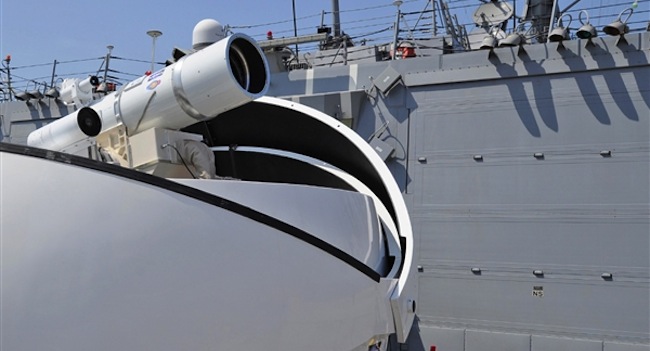We’ve been keeping a close, close eye on the U.S. Navy’s Laser Weapons System since it first appeared, and the more we heard about it, the more we were impressed. This summer, one lucky ship will be saddled with the system: if I were you, I would avoid the USS Ponce.

The Navy’s Laser System looks like a small white cannon, and uses invisible infrared energy to destroy drones or small boats, both things that could threaten US forces. The system could destroy an infinite number of these smaller targets, lasers not being something you’ll run out of. The USS Ponce will be stationed along the Persian Gulf in the Middle East, where it will deploy the system for the first time this summer.
While the Laser System, more commonly known as LaWs, is certainly an impressive and safer new technology for our military, the Navy will also be using rail guns for larger targets, a less expensive alternative to missile use. These rail guns use a small projective, which is placed on parallel conducting rails, in conjunction with an electric charge that accelerates the projectile, which is then sent flying at a target at around six or seven times the speed of sound. The projectiles weigh an average of seven pounds, and do a significant amount of damage to their targets at that velocity.
While the USS Ponce will be able to protect itself from smaller targets much more effectively, they will not be receiving rail guns: both technologies require a huge amount of energy, and the Navy does not have any ships that will be able to handle such a gargantuan amount of power, though they are in the process of constructing one in Maine. That ship, the USS Zumwalt, will have no problem using both rail guns and the Laser System, as it will have around 78 megawatts of power available.
Furthermore, the Ponce will have to tread carefully in bad weather: despite its amazing technology, the effectiveness of lasers diminishes drastically in rain, dusty air, or cloudy skies. LaWs won’t be totally useless, but the Navy will prudently be keeping other weapons on hand for such an instance.
After the new system is deployed, the Navy will turn their focus on other ways to use lasers, perhaps with weapons that can eliminate higher-powered targets or combatants. We’re probably still a long way from seeing a laser blow up an enemy warship, but at least we’re safer from drones.
Source Mashable
Advertisement
Learn more about Electronic Products Magazine





